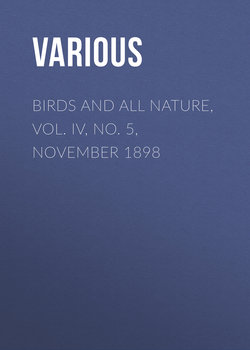Читать книгу Birds and All Nature, Vol. IV, No. 5, November 1898 - Various - Страница 6
THE SLEEPING-PLACES OF BIRDS
ОглавлениеIT IS difficult to imagine a spot with fewer domestic features to adorn the home than a piece of the bare ceiling of a tropical veranda; but the attachment of animals to their chosen sleeping-places must rest on some preference quite clear to their own consciousness, though not evident to us. In some instances the ground of choice is intelligible. Many of the small blue British Butterflies have grayish spotted backs to their wings. At night they fly regularly to sheltered corners on the chalk downs where they live, alight head downwards on the tops of the grasses which there flourish, and closing and lowering their wings as far as possible, look exactly like seed-heads on the grasses. If the night is cold they creep down the stem and sleep in shelter among the thick lower growth of grass. The habits of birds in regard to sleep are very unlike, some being extremely solicitous to be in bed in good time, while others are awake and about all night. But among the former the sleeping-place is the true home, the domus et penetralia. It has nothing necessarily in common with the nest, and birds, like some other animals and many human beings, often prefer complete isolation at this time. They want a bedroom to themselves. Sparrows, which appear to go to roost in companies, and sometimes do so, after a vast amount of talk and fuss, do not rest cuddled up against one another, like Starlings or Chickens, but have private holes and corners to sleep in. They are fond of sleeping in the sides of straw-ricks, but each Sparrow has its own little hollow among the straws, just as each of a flock of sleeping Larks makes its own "cubicle" on the ground. A London Sparrow for two years occupied a sleeping-home almost as bare of furniture as the ceiling which the East Indian Butterfly frequented. It came every night in winter to sleep on a narrow ledge under the portico of a house in Onslow Square. Above was the bare white-washed top of the portico, there were no cosy corners, and at eighteen inches from the Sparrow was the gas-lit portico lamp. There every evening it slept, and guests leaving the house seldom failed to look up and see the little bird fast asleep in its enormous white bedroom. Its regular return during two winters is evidence that it regarded this as its home; but why did it choose this particular portico in place of a hundred others in the same square? —Spectator.
Bird Courtships. – When he (the Flicker) wishes to charm his sweetheart he mounts a very small twig near her, so that his foreparts shall not be hidden as he sits upright in regular Woodpecker attitude, and he lifts his wings, spreads his tail, and begins to nod right and left as he exhibits his mustache to his charmer, and sets his jet locket first on one side of the twig and then the other. He may even go so far as to turn his head half around to show her the pretty spot on his "back hair." In doing all this he performs the most ludicrous antics, and has the silliest of expressions of face and voice, as if in losing his heart, as some one phrases it, he has lost his head also. For days after she has evidently said yes, he keeps it up to assure her of his devotion, and, while sitting crosswise on a limb, a sudden movement of hers, or even a noise made by one passing, will set him to nodding from side to side. To all this she usually responds in kind. —Baskett.
